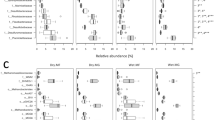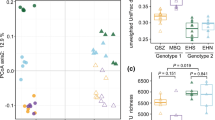Abstract
The effects of salt stress on endophytic prokaryotic communities in plants are largely unknown, and the distribution patterns of bacterial and archaeal endophytes in different tissues of a plant species are rarely compared. We investigated the endophytic bacterial and archaeal communities in roots, stems and leaves of the common reed, Phragmites australis, collected from three tidal zones along a salinity gradient, using terminal restriction fragment (T-RF) length polymorphism analysis of the 16S rRNA genes. The results showed that the bacterial diversity in the roots was significantly higher than that in the leaves, whereas similar archaeal diversity was revealed for either plant tissues or tidal zones. Network analysis revealed that T-RFs were grouped largely by tissue, and the major groups were generally linked by a few common T-RFs. Unique T-RFs in roots were mainly present in plants growing in the supratidal zone, but unique T-RFs in stems and leaves were mainly present in those from the middle and high tidal zones. Non-metric multidimensional scaling ordination and analysis of similarity revealed that bacterial communities were significantly different among tissues (P < 0.05), but similar among tidal zones (P = 0.49). However, the archaeal communities differed among tidal zones (P < 0.05), but were similar among tissues (P = 0.89). This study indicates that: (1) the endophytic archaeal communities are influenced more significantly than the endophytic bacterial communities by soil salinity, and (2) the differential distribution patterns of bacterial and archaeal endophytes in plant tissues along a salinity gradient imply that these two groups play different roles in coastal hydrophytes.







Similar content being viewed by others
References
Bascompte J (2009) Disentangling the web of life. Science 325:416–419. doi:10.1126/science.1170749
Chelius MK, Triplett EW (2001) The diversity of Archaea and Bacteria in association with the roots of Zea mays L. Microb Ecol 41:252–263. doi:10.1007/s002480000087
Chen W, Tang Y, Mori K, Wu X (2012) Distribution of culturable endophytic bacteria in aquatic plants and their potential for bioremediation in polluted waters. Aquat Biol 15:99–110. doi:10.3354/ab004422
Chi F, Shen S-H, Cheng H-P, Jing Y-X, Yanni YG, Dazzo FB (2005) Ascending migration of endophytic Rhizobia, from roots to leaves, inside rice plants and assessment of benefits to rice growth physiology. Appl Environ Microbiol 71:7271–7278. doi:10.1128/AEM.71.11.7271-7278.2005
Cohen AC, Bottini R, Piccoli PN (2008) Azospirillum brasilense Sp 245 produces ABA in chemically-defined culture medium and increases ABA content in arabidopsis plants. Plant Growth Regul 54:97–103. doi:10.1007/s10725-007-9232-9
Compant S, Clément C, Sessitsch A (2010) Plant growth-promoting bacteria in the rhizo- and endosphere of plants: their role, colonization, mechanisms involved and prospects for utilization. Soil Biol Biochem 42:669–678. doi:10.1016/j.soilbio.2009.11.024
Compant S, Sessitsch A, Mathieu F (2012) The 125th anniversary of the first postulation of the soil origin of endophytic bacteria—a tribute to M.L.V. Galippe. Plant Soil 356:299–301. doi:10.1007/s11104-012-1204-9
Couillerot O, Ramírez-Trujillo A, Walker V, von Felten A, Jansa J, Maurhofer M, Défago G, Prigent-Combaret C, Comte G, Caballero-Mellado J, Moënne-Loccoz Y (2012) Comparison of prominent Azospirillum strains in Azospirillum–Pseudomonas–Glomus consortia for promotion of maize growth. Appl Microbiol Biotechnol 97:4639–4649. doi:10.1007/s00253-012-4249-z
Franken P (2012) The plant strengthening root endophyte Piriformospora indica: potential application and the biology behind. Appl Microbiol Biotechnol 96:1455–1464. doi:10.1007/s00253-012-4506-1
Germaine KJ, Liu X, Cabellos GG, Hogan JP, Ryan D, Dowling DN (2006) Bacterial endophyte-enhanced phytoremediation of the organochlorine herbicide 2,4-dichlorophenoxyacetic acid. FEMS Microbiol Ecol 57:302–310. doi:10.1111/j.1574-6941.2006.00121.x
Gorai M, Ennajeh M, Khemira H, Neffati M (2011) Influence of NaCl-salinity on growth, photosynthesis, water relations and solute accumulation in Phragmites australis. Acta Physiol Plant 33:963–971. doi:10.1007/s11738-010-0628-1
He X-J, Mu R-L, Cao W-H, Zhang Z-G, Zhang J-S, Chen S-Y (2005) AtNAC2, a transcription factor downstream of ethylene and auxin signaling pathways, is involved in salt stress response and lateral root development. Plant J 44:903–916. doi:10.1111/j.1365-313X.2005.02575.x
Ho Y-N, Mathew DC, Hsiao S-C, Shih C-H, Chien M-F, Chiang H-M, Huang C–C (2012) Selection and application of endophytic bacterium Achromobacter xylosoxidans strain F3B for improving phytoremediation of phenolic pollutants. J Hazard Mater 219–220:43–49. doi:10.1016/j.jhazmat.2012.03.035
Karthikeyan B, Joe MM, Islam MR, Sa T (2012) ACC deaminase containing diazotrophic endophytic bacteria ameliorate salt stress in Catharanthus roseus through reduced ethylene levels and induction of antioxidative defense systems. Symbiosis 56:77–86. doi:10.1007/s13199-012-0162-6
Li YH, Zhu JN, Zhai ZH, Zhang Q (2010) Endophytic bacterial diversity in roots of Phragmites australis in constructed Beijing Cuihu Wetland (China). FEMS Microbiol Lett 309:84–93. doi:10.1111/j.1574-6968.2010.02015.x
Lin L, Guo W, Xing Y, Zhang X, Li Z, Hu C, Li S, Li Y, An Q (2012) The actinobacterium Microbacterium sp. 16SH accepts pBBR1-based pPROBE vectors, forms biofilms, invades roots, and fixes N2 associated with micropropagated sugarcane plants. Appl Microbiol Biotechnol 93:1185–1195. doi:10.1007/s00253-011-3618-3
Lindow SE, Brandl MT (2003) Microbiology of the phyllosphere. Appl Environ Microbiol 69:1875–1883. doi:10.1128/AEM.69.4.1875-1883.2003
Luo S, Xu T, Chen L, Chen J, Rao C, Xiao X, Wan Y, Zeng G, Long F, Liu C, Liu Y (2012) Endophyte-assisted promotion of biomass production and metal-uptake of energy crop sweet sorghum by plant-growth-promoting endophyte Bacillus sp. SLS18. Appl Microbiol Biotechnol 93:1745–1753. doi:10.1007/s00253-011-3483-0
Mahaffee WF, Kloepper JW (1997) Temporal changes in the bacterial communities of soil, rhizosphere, and endorhiza associated with field-grown cucumber (Cucumis sativus L.). Microb Ecol 34:210–223. doi:10.1007/s002489900050
Mano H, Morisaki H (2008) Endophytic bacteria in the rice plant. Microbes Environ 23:109–117
Mano H, Tanaka F, Nakamura C, Kaga H, Morisaki H (2007) Culturable endophytic bacterial flora of the maturing leaves and roots of rice plants (Oryza sativa) cultivated in a paddy field. Microbes Environ 22:175–185
Ryan RP, Germaine K, Franks A, Ryan DJ, Dowling DN (2008) Bacterial endophytes: recent developments and applications. FEMS Microbiol Lett 278:1–9. doi:10.1111/j.1574-6968.2007.00918.x
Springer NM (2010) Isolation of plant DNA for PCR and genotyping using organic extraction and CTAB. Cold Spring Harb Protoc. doi: 10.1101/pdb.prot5515
Sturz AV, Christie BR, Matheson BG, Nowak J (1997) Biodiversity of endophytic bacteria which colonize red clover nodules, roots, stems and foliage and their influence on host growth. Biol Fertil Soils 25:13–19. doi:10.1007/s003740050273
Sun L, Qiu F, Zhang X, Dai X, Dong X, Song W (2008) Endophytic bacterial diversity in rice (Oryza sativa L.) roots estimated by 16S rDNA sequence analysis. Microb Ecol 55:415–424. doi:10.1007/s00248-007-9287-1
Vasquez EA, Glenn EP, Guntenspergen GR, Brown JJ, Nelson SG (2006) Salt tolerance and osmotic adjustment of Spartina alterniflora (Poaceae) and the invasive M haplotype of Phragmites australis (Poaceae) along a salinity gradient. Am J Bot 93:1784–1790. doi:10.3732/ajb.93.12.1784
Weyens N, van der Lelie D, Taghavi S, Vangronsveld J (2009) Phytoremediation: plant–endophyte partnerships take the challenge. Curr Opin Biotechnol 20:248–254. doi:10.1016/j.copbio.2009.02.012
Acknowledgments
The work was financially supported by the Main Direction Program of Knowledge Innovation of CAS (Grant no. KSCX2-EW-G-12B), Shandong Natural Science Foundation for Distinguished Young Scholars (No. JQ201210), the Open Fund of MOIDAT (Grant no. 201318), and the One Hundred Talent Program of CAS awarded to Jun Gong.
Author information
Authors and Affiliations
Corresponding author
Rights and permissions
About this article
Cite this article
Ma, B., Lv, X., Warren, A. et al. Shifts in diversity and community structure of endophytic bacteria and archaea across root, stem and leaf tissues in the common reed, Phragmites australis, along a salinity gradient in a marine tidal wetland of northern China. Antonie van Leeuwenhoek 104, 759–768 (2013). https://doi.org/10.1007/s10482-013-9984-3
Received:
Accepted:
Published:
Issue Date:
DOI: https://doi.org/10.1007/s10482-013-9984-3




